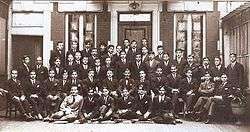Ministry of Education (Azerbaijan)
| Azərbaycan Respublikasının Təhsil Nazirliyi | |
|
Emblem of the Ministry of Education | |
| Agency overview | |
|---|---|
| Formed | May 18, 1918 |
| Headquarters | 49 Khatai Avenue, Baku, Azerbaijan Republic AZ1008 |
| Agency executives |
|
| Child agency |
|
| Website | www.edu.gov.az |
The Ministry of Education of Azerbaijan Republic (Azerbaijani: Azərbaycan Respublikasının Təhsil Nazirliyi) is a governmental agency within the Cabinet of Azerbaijan in charge of regulating the education system in Azerbaijan. The ministry is headed by Mikayil Jabbarov.[1]
History
The Education Ministry was one of the government agencies established on May 18, 1918 when Azerbaijan Democratic Republic declared independence. The first agency named the Ministry of Public Enlightenment consisted of three departments: General Secondary Education, Higher and Secondary Specialized Education, Vocational Schools. Council of Ministers of Azerbaijan approved the motion on June 30, 1920.

After Soviet rule was established in Azerbaijan on April 28, 1920, the ministry was transformed into the Commissariat of Public Enlightenment by the decree No.1 of the Council of Ministers of Azerbaijan SSR bringing all educational institutions in the republic under its direct supervision. In 1940, Council of Ministers approved creation of a separate government agency Department of Labour Reserves which would oversee the activities of vocational institutions. In 1959, the authorities transformed the entity into State Committee of Vocational Education which functioned until 1988. In 1959, Council of Ministers also approved establishment of the Committee of Higher and Secondary Special Education transferring all institutions of secondary and higher education under its control which from 1964 until 1988 acted as an independent government agency. In 1988 all education agencies were abolished by the decree of the Council of Ministers and Ministry of National Education was founded in their place. The Ministry was reorganized into Ministry of Education by the Presidential order on September 3, 1993. The ministry regulations were approved by the Presidential decree dated March 1, 2005. In 2013 Mikayil Cabbarov was appointed the Minister of Education.
Structure
The ministry is headed by the minister and three deputy ministers. There is also a separate Education Department for Baku.[2] Functions of the ministry include but are not limited to enforcing government procedures and policies in the education sector, determining the development concepts of the education system of Azerbaijan and preparation of government programs for their realization; protection of rights of citizens to receive proper education, create conditions for equality in educational institutions; ensuring quality of the education given to citizens of the country; creation of economic and organizational models according to modern standards; enforce democratic mechanisms in the management; forecast the workforce demand markets in education of specialized professionals; increasing scientific and procedural potential in educational institutions; organization and development of international relations in the education sector and so forth.[3] Currently there are 36 state-run and 15 private universities in Azerbaijan. The ministry-released reports state that in 2009 20,953 undergraduate students and 3,526 graduate students entered in universities nationwide. Currently, there are 104,925 undergraduate and graduate students, studying in higher education institutions, excluding the specialized higher education schools. Universities employ 11,566 professors and 12,616 faculty members in the country.[4][5]
See also
References
- ↑ "CIA. Chiefs of State and Cabinet Members of Foreign Governments". Retrieved 2010-11-03.
- ↑ "Ministry of Education of Azerbaijan Republic. General information". Retrieved 2010-11-03.
- ↑ "Tourism Portal. Ministry of Education". Retrieved 2010-11-03.
- ↑ "Senior official raps higher education in Azerbaijan". Baku: 1news.az. 2010-06-18. Retrieved 2010-11-03.
- ↑ "ALİ VƏ ORTA İXTİSAS TƏHSİLİ SAHƏSİ ÜZRƏ 2009-CU İLDƏ GÖRÜLMÜŞ İŞLƏRƏ DAİR HESABAT" [Report on Works in Secondary and Higher Education Sector in 2009]. Retrieved 2010-11-04.
External links
- Education Portal of Azerbaijan Republic
- Overview of Education System in Azerbaijan as provided by World Higher Education Database
